Part Five: End of the Master Mold
Back in New York, what remained of the Master Mold that had been destroyed by Power Pack gave one last stab at life. As had happened in Alaska, the small mechanism that remained was discovered by a construction worker,  attempting to rebuild the area previously destroyed by the battle. However, unlike the earlier occasion, this construction worker was not truly human, but a synthetic being who had taken human form and the human identity of Nicolas Hunter. In a truly ironic turn, this being was in truth also a Sentinel, albeit from another, possible future. Its name was Nimrod. Now interfacing with another Sentinel unit, one far more sophisticated than its own, the Master Mold quickly took control of Nimrod’s system, reconfiguring it to its own within moments. Before Nimrod could begin to resist, the Master Mold had usurped its body and was reborn. [Uncanny X-Men #246]
attempting to rebuild the area previously destroyed by the battle. However, unlike the earlier occasion, this construction worker was not truly human, but a synthetic being who had taken human form and the human identity of Nicolas Hunter. In a truly ironic turn, this being was in truth also a Sentinel, albeit from another, possible future. Its name was Nimrod. Now interfacing with another Sentinel unit, one far more sophisticated than its own, the Master Mold quickly took control of Nimrod’s system, reconfiguring it to its own within moments. Before Nimrod could begin to resist, the Master Mold had usurped its body and was reborn. [Uncanny X-Men #246]
Called into action at the construction site by the chaos, the X-Men immediately recognized the threat of the Master Mold, though not completely its design or greater significance. The Master Mold in turn was limited in its countermeasures against the X-Men, not only because of the ongoing process of integrating Nimrod’s systems into its own, but by the fact that, during this time, the X-Men enjoyed a magical cloak of invisibility against electronic detection, granted by the Ominiversal Majestrix Roma. However, as Nimrod had been as close to a living being as possible for an artificial lifeform, once the integration was complete, Master Mold found itself able to target the X-Men.
During the course of the subsequent battle, the X-Men managed to destroy the Master Mold’s body, though not with finality. Always, the Sentinel began to incorporate more materials into its form to rebuild itself. It soon became clear that theirs was a lost cause. However, in a stoke of inspiration, Dazzler considered the mystical artifact called the Siege Perilous. Given to them by Roma as a manner by which they could leave this life and start anew by being reborn, the Siege Perilous resembled a small amulet in its normal form, but could grow into an immense gateway through which one might step.
Postulating that the only way to win the day would be to send the Sentinel where it couldn’t do any more harm, Dazzler threw the artifact behind the Master Mold, which had been reduced to that of a gigantic head. Immediately, the Siege Perilous grew to a size to accommodate what remained of the Master Mold, but the Sentinel resisted still by constructing tentacles to anchor itself from the pan-dimensional portal. It was only due to
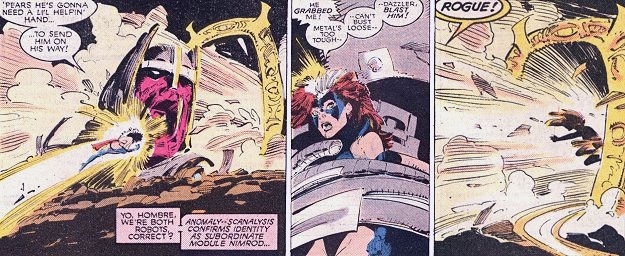
the strength of Rogue, combined with the remnants of the Nimrod consciousness, that severed the Master Mold from its moorings, sending it tumbling into the portal of the Siege Perilous. Still integrated, Nimrod suffered the same fate as the Master Mold, as did Rogue, who was being held by the Sentinel’s tentacles. Once the two (or three) entities crested the threshold, the portal closed and the Siege Perilous returned to that of an amulet. [Uncanny X-Men #247]
Still, this was never to be a definitive ending for neither Rogue nor the Master Mold (nor possibly Nimrod). An ancient, extra-dimensional, magical artifact, the portal of the Siege Perilous allows those who pass through its threshold to be judged by the “highest of powers.” So judged, the individual’s good and ill are weighed in the cosmic balance and they are born again – given a second chance to redeem themselves. Indeed, the device was never to be an instrument of finality, but a chance at rebirth. Rogue herself emerged from the Siege Perilous some months later, reborn and given the chance to finally solve the problem of her merged personality with that of Carol Danvers’. However, years passed before it became apparent how the “highest of powers” had judged Master Mold or Nimrod, or what their infinite wisdom had determined. Even then, once its decision was made known, it called into question the wisdom of the judgment.
More curious, it seems that the Master Mold itself was not judged alone. The higher power considered the personality of Nimrod, which the Master Mold had striven to incorporate as part of itself, as an inseparable part of the Master Mold.  As Nimrod’s own programming had been evolving over the previous months from that of a cold-blooded, mutant-hunting machine to one that cared for justice and that which was right, it could be that the higher power believed that there was value to leaving merged the personality looking for redemption to the personality seemingly beyond it. Additionally, with most of what was Steven Lang having died with the Master Mold months before, it could be argued that there was little to truly judge.
As Nimrod’s own programming had been evolving over the previous months from that of a cold-blooded, mutant-hunting machine to one that cared for justice and that which was right, it could be that the higher power believed that there was value to leaving merged the personality looking for redemption to the personality seemingly beyond it. Additionally, with most of what was Steven Lang having died with the Master Mold months before, it could be argued that there was little to truly judge.
Whatever the reasoning or logic behind the higher powers, what was once two robotic entities would re-emerge as a man of flesh and blood. In time, the man would take the name of Bastion and his life would slowly but inexorably return to the world of Sentinels – and the specific type of Sentinel called the Master Mold.
Part Six: Days of Other Projects
In his mad quest of genocide, Steven Lang had constructed the third generation of Sentinels. Through his misunderstanding of the technology originated by the Trasks, he lost his own mind, while at the same time lending his madness to the artificial intelligence circuits of a Master Mold unit, whose own imperative led to its own destruction. However, between the fall of Lang and his pseudo-resurrection as a robotic entity, the world was not without those who saw Sentinels as the answer to the “mutant question.”
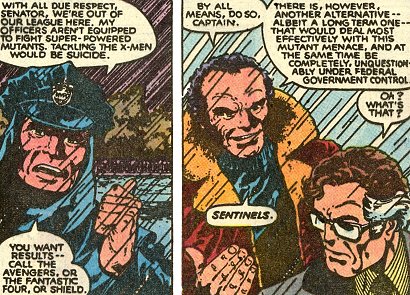 Ironically, the first to suggest their use was a mutant himself, Sebastian Shaw. As leader of the Inner Circle, whose predecessor, the Council of Chosen – the organization which had funded Steven Lang – Shaw had access to Trask and Lang’s Sentinel technology. After a conflict between the Inner Circle and the X-Men went awry, Shaw turned to the Sentinels and worked to obtain government funding from anti-mutant politicians, such as Senator Robert Kelly. [X-Men (1st series) #135, Uncanny X-Men #142] While Shaw’s Sentinel program never seemed to go into mass production, it was maintained on some level for years. However, during all of that time, it was never apparent that he employed a Master Mold unit. Most likely, after the problems of both Trasks and Lang, Shaw learned from their mistakes and declined to repeat them.
Ironically, the first to suggest their use was a mutant himself, Sebastian Shaw. As leader of the Inner Circle, whose predecessor, the Council of Chosen – the organization which had funded Steven Lang – Shaw had access to Trask and Lang’s Sentinel technology. After a conflict between the Inner Circle and the X-Men went awry, Shaw turned to the Sentinels and worked to obtain government funding from anti-mutant politicians, such as Senator Robert Kelly. [X-Men (1st series) #135, Uncanny X-Men #142] While Shaw’s Sentinel program never seemed to go into mass production, it was maintained on some level for years. However, during all of that time, it was never apparent that he employed a Master Mold unit. Most likely, after the problems of both Trasks and Lang, Shaw learned from their mistakes and declined to repeat them.
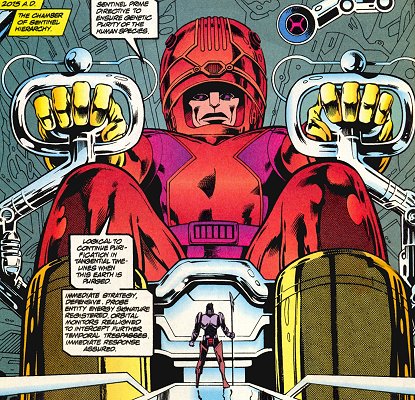 In the alternate future timeline known as the Days of Future Past, where Shaw’s Project: Wideawake had become a fully authorized and publicly-demanded program, the Sentinel Units were indeed mass produced. These units were not only manufactured by a Master Mold unit but, like Bolivar Trasks’ generation, they also received their orders from it. Unfortunately, also like Bolivar Trasks’ unit, this Master Mold also decided that the best way to fulfill the Sentinels’ imperative of mutant extermination was the control of humanity. As such, within 12 years of their activation, the Sentinels and the Master Mold controlled what remained of the United States. [X-Men (1st series) #141, Excalibur (1st series) #52]
In the alternate future timeline known as the Days of Future Past, where Shaw’s Project: Wideawake had become a fully authorized and publicly-demanded program, the Sentinel Units were indeed mass produced. These units were not only manufactured by a Master Mold unit but, like Bolivar Trasks’ generation, they also received their orders from it. Unfortunately, also like Bolivar Trasks’ unit, this Master Mold also decided that the best way to fulfill the Sentinels’ imperative of mutant extermination was the control of humanity. As such, within 12 years of their activation, the Sentinels and the Master Mold controlled what remained of the United States. [X-Men (1st series) #141, Excalibur (1st series) #52]
Under this Master Mold’s watch, millions of both humans and mutants perished, as the country lapsed into anarchy and its cities into ruins. The nightmare of this world was finally put to an end when a group of mutants traveled through time, arriving from twenty years in the past. The group, calling itself Excalibur, defied the odds of a world filled with millions of Sentinels by attacking the Master Mold’s facility directly. While the rest of the team held back the facility’s defense units, Rachel Summers and Widget combined their abilities to reprogram the Master Mold unit and, therefore, all Sentinels on the planet simultaneously. No longer programmed to exterminate mutants, their first directive became to protect all life. Their mission accomplished, Excalibur returned to their own time. [Excalibur (1st series) #66-67]
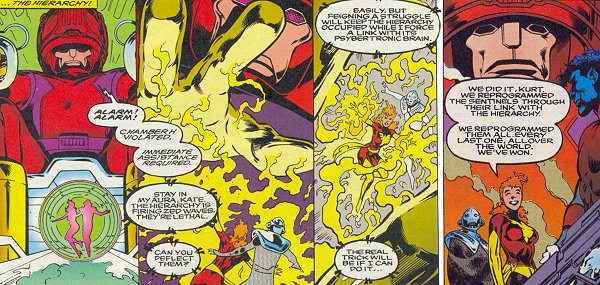
Not surprisingly, the alternate timeline to which Excalibur traveled was not the only one where a Sentinel program went wrong. Another such reality would be a future influenced by an powerful and corrupt organization called Weapon X. Just as Bolivar Trask had worked to eliminate the threat of mutants, so too did Weapon X strive to determine an ultimate solution. Unlike Trask’s theirs included the recruitment and transformation of mutants themselves into anti-mutant agents. One of the mutants eventually recruited by program director Malcolm Colcord was a man named Madison Jeffries, who possessed the ability to reshape psionically any artificial substance into new forms. Initially, the brainwashed Jeffries created simple Boxbot robots, based off of the design of his old “Box” armor he had used as a member of Alpha Flight. [Weapon X (2nd series) #1]
However, as years passed in a possible future timeline, his responsibility changed to creating Sentinels, doing so individually by himself. Eventually, the task became more and more physically exhausting to Jeffries, until one of his Boxbots took the surprising initiative of constructing more Sentinels while Jeffries rested. Unfortunately for Jeffries, this was still not enough for the Boxbot, and eventually the Boxbot evolved itself into a Sentinel unit, into whose head the unwitting Jeffries was placed. Now living a shadow of a man, Jeffries existed
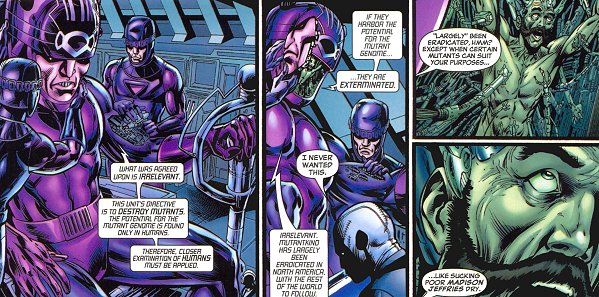
only as a nearly comatose CPU for the Boxbot’s task of Sentinel construction. To reflect this change in status, the Boxbot declared itself “Mastermold” and proceeded to command the existing army of Sentinels, even as it continued to expand it. Like its counterpart in the “Days of Future Past” timeline, the Sentinels proceeded to deny subordination to its former masters and take over the world, enslaving humanity as it exterminated mutants and reducing the civilization it was designed to protect to ruins. [Weapon X: Days of Future Now #5]
